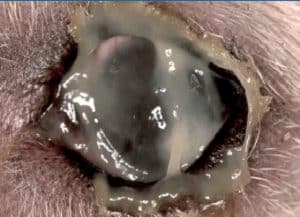Dry Eye
Keratoconjunctivitis sicca, otherwise known as ‘KCS’ or ‘dry eye’ is a condition of dogs and very occasionally cats caused by insufficient tear production.
What causes dry eye?
There are many causes of dry eye, including: congenital disorders, infections (canine distemper virus), drug-induced, removal of the lacrimal gland of the third eyelid (cherry eye), Diabetes mellitus and hypothyroidism. The majority of cases we see are auto- immune disorders, where the animal’s own immune system attacks the lacrimal (tear) gland and reduces tear production.
Can all dogs get it?
Yes, it is possible for all dogs to get the condition but it is most commonly seen in certain breeds such as the Cocker Spaniel, Shih Tzu, Lhasa Apso, Bulldog, Schnauzer and West Highland White Terrier.
What are the symptoms?
The clinical signs of dry eye include the following symptoms:
- Heavy mucus production
- Rubbing at eyes
- Recurrent conjunctivitis
- Recurrent ulceration
- Cloudy eyes
- Corneal ulcers
After an extended period of dryness, the surface of the eye (the cornea) begins to develop chronic pigmentary keratitis, where dark pigmentation spreads across the corneal surface, often causing diminished vision.
How is it diagnosed?
If the above symptoms are seen then your vet can perform a Schirmer tear test. This involves putting special strips of blotting paper in the lower eyelid. The tears wet the paper strip, which is marked in millimeters along its edge. We measure how far the paper wets in a minute. Some strips have a line of blue ink to colour the paper as the tears wet it, and make it easier to see. Normally, the tears wet the paper strip between 15 and 25 mm in a minute.
You should ask your vet to measure your dog’s tear production every time you visit if your dog is one of the following breeds:
- Cocker Spaniel
- Shih Tzu
- Lhasa Apso
- Bulldog
- Schnauzer
- West Highland White Terrier
This is because treatment should be started as soon as possible once the tear production starts to decrease. It can take up to 4-6 weeks for the medication to increase tear production, and it is much more effective to raise lowered tear production than to try to restart tear production from zero. Therefore, successful treatment requires early diagnosis.
How is it treated?
Treatment goals for dry eye include: stimulation of tear production, lubrication of the eye surface and decreasing the scar tissue. In the last few years, the use of topical Cyclosporin has made an incredible difference in the successful treatment of KCS. New lubricants have also helped to keep patients eyes comfortable. If these treatments fail to increase tear production, then your pet may be referred to Eye Vet for more intensive treatment.
How long does the treatment last?
The renewed tear production is dependent on the presence of the medications, so once a medical treatment plan is started, it is important to continue the medications as directed. Treatment is required for the rest of the dog’s life. When on treatment it is crucial that you have your dog checked regularly to monitor treatment success.
What if the medication fails to increase tears
If the medication fails to raise tear levels, resulting in a painful and dry eye, then as a very last resort an operation can be performed at Eye-Vet. This surgery is called a parotid duct transposition. It involves moving the tiny parotid salivary gland duct from its position opening into the mouth, and placing it under the eyelid, so that the eye is lubricated by saliva.
Patient following parotid duct transposition surgery. The cornea is sufficiently wet with saliva. Some corneal pigmentation remains but medication aims to reduce this with time.
Whilst this delicate surgery is usually successful, there can be complications:
- the salivary gland may not make enough saliva to wet the eye
- the surgery involves making a tiny tube turn at right angles and so it can get blocked
- some dogs can make too much saliva and this runs down the face
- saliva has a different composition to tears, it contains other chemicals and is more alkaline – this can result in crystals forming on the surface of the eye or even irritating the eye. This may require a change of diet to try and change the pH of the ‘saliva tears’.
